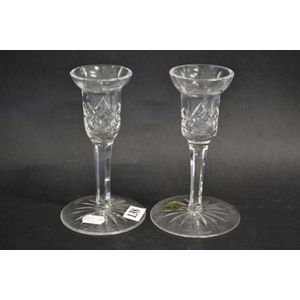Georgian Jacobite Sympathy Wine Glass
Georgian Jacobite sympathy wine glass, c.1750, with funnel shaped bowl, with rose and butterfly engravings representing Jacobite sympathiser and loyalty, above a light baluster stem on circular foot, height 17 cm. Provenance: A number of pieces of the collection featured in the 'Circle of Glass Collectors Commemorative Exhibition 1937 - 1962', Victoria and Albert Museum, London, 1962 and 'Exhibition of English Glass', Victoria and Albert Museum, 1968
You must be a subscriber, and be logged in to view price and dealer details.
Subscribe Now to view actual auction price for this item
When you subscribe, you have the option of setting the currency in which to display prices to $Au, $US, $NZ or Stg.
This item has been sold, and the description, image and price are for reference purposes only.
- Bowl - With drinking glasses, the bowl is the hollow section of the glass that holds the liquid. Many glasses were mounted on a stem joined to a foot, others were cylindrical, of tumbler shape. The size and shape of the bowl was determined by the type of liquids they were meant to hold. Shapes used included bell shaped, conical (funnel), bucket shaped, trumpet, cup, ogee, funnel, cylindrical and rounded.
- Stem - In drinking glasses the stem is that section of the glass that joins the bowl to the foot. In mass produced glasses is usually solid and of cylindrical shape, but in antique drinking glasses it may be long and short and in various styles or with decoration, such as air twist, baluster, collared, faceted, hollow, knopped, teardrop, twisted or incised.
- Jacobite - Wine glasses engraved with mottos and symbols of the Jacobites, who were supporters of Prince Charles Edward Stuart's claim to the English throne.
They were passed around amongst the members of secret groups devoted to the restoration of a Catholic monarch in Scotland and England under the House of Stuart.
The last Jacobite Rebellion ended with Charles Edward Stuart?s defeat at the Battle of Culloden in 1746. His image features on some of the Jacobite glassware.
Genuine examples of Jacobite glassware are dated between 1746 and 1788 but many later copies and forgeries are in circulation.
In November 2012 a Jacobite "Amen" glass, the rarest group of Jacobite glasses sold for £43,000 at auction in Shropshire, England. - Georgian - As an English stylistic period, Georgian is usually taken to cover the period from George I (1714) to the Regency of Prince George (1811-20), although the period from 1800 to 1830 is sometimes designated as the Regency period. During the Georgian period the great English cabinetmakers and designers such as Chippendale, Hepplewhite, Adam Sheraton etc., were all active.
Therefore there isn't a single 'Georgian style' as such and to say something is 'Georgian', usually means it was made between 1714 and 1830. This assumes we discount George V and George VI, both being from the 20th century.
The styles popular at the time of each reign were:
George I (1714-1727) saw out the last years of the Baroque period.
George II (1727-1760) reigned during the Rococo period.
George III (1760-1820) saw the last gasp of the Rococo, all of the early Neo-Classic 'Adam style' and most of the later neo-Classic 'Regency style'.
George IV (Prince Regent 1820-1830)encompassed the last of the 'Regency' style.
William IV's reign (1830-1837) was something of a no man's land (stylistically) and he wasn't a 'George' anyway. He covered the last glimmerings of 'Regency' and the start of the 'Victorian' style. - Baluster (glass) - An architectural term for a column in a balustrade or staircase.
When used to describe glass, it can either refer to the shape of the stem of a wine glass, being slender above and pear shaped below, or the shape of the whole vessel, usually a vase. In fact the baluster shape is often described as being vase-like.
The description of a vase as being of baluster shape covers a wide variety of shapes that often bear no resemblance to the original architectural form.
This item has been included into following indexes:
Visually similar items

Pair of Waterford Crystal candlesticks
Sold by
in
for
You can display prices in $Au, $US, $NZ or Stg.

George III tear drop glass, with a trumpet bowl and tear drop stem on folded foot. Together with a similar, 18th century glass with a tear drop stem
Sold by
in
for
You can display prices in $Au, $US, $NZ or Stg.

A huon pine turned pedestal, Tasmanian origin, late 19th century, 120 cm high, 31 cm wide, 26 cm
Sold by
in
for
You can display prices in $Au, $US, $NZ or Stg.

Waterford Crystal 8 inch pair of 'Ovoture' candlesticks (boxed)
Sold by
in
for
You can display prices in $Au, $US, $NZ or Stg.
